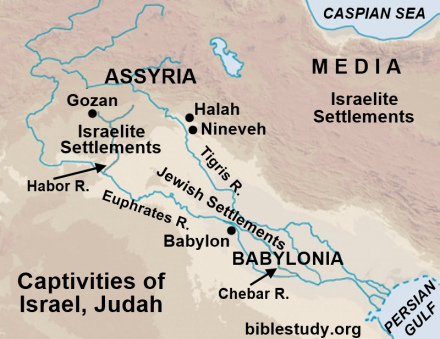Israel existed, long before being taken into captivity, as a unified kingdom under Saul (reigned from 1050 to 1010 B.C.), King David (1010 - 970) and Solomon (970 - 930). Soon after the death of Solomon, however, the kingdom divided into two separate pieces with each possessing their own line of rulers.
Ten of the tribes formed the Northern Kingdom (also known as the Kingdom of Israel in the Bible) with rulers descended from Jeroboam I (reigned 930 to 909 B.C.). Two of the tribes (Benjamin, Judah), along with the tribe of Levi (the priests who served the temple), created the Southern Kingdom or Kingdom of Judah. Their rulers were the descendants of King David. Rehoboam (930 to 913 B.C.) was the first King of the Jews.
Assyria flexes its might
The start of the northern ten tribes (Kingdom of Israel) captivity and ultimate demise began during the reign of Tiglathpileser, king of Assyria, who ruled from 745 to 727 B.C.
During Tiglathpileser's reign he came into the land and took the inhabitants of the tribes of Asher, Naphtali, Zebulun and Dan as prisoners. He also conquered areas east of the Jordan River and took the tribes of Gad, Reuben, and part of the tribe of Manasseh as well (2Kings 15:29, see also 1Chronicles 5:26).

In 732 B.C. Hoshea became the last King of Israel when he assassinated King Pekah (2Kings 15:30). Although He paid tribute money to the Assyrian Empire for a few years, he stopped doing so shortly after a new Assyrian ruler, King Shalmaneser V, assumed the throne in 727.
Shalmaneser, angry that no tribute was being paid, and finding out the Hoshea was secretly seeking an Egyptian military alliance, acted swiftly against Israel.
Around 725 B.C. the Assyrians begin to attack the Kingdom of Israel and its capital Samaria (2Kings 17:5). In 723 the capital city of Samaria falls. The people remaining in the land are taken into captivity (verse 6). God allows this to happen as punishment for the nation's many sins that they refused to repent of (2Kings 17:7 - 23). Because of their sins, chief of which was idolatry, the kingdom lasted only 208 years.
The southern kingdom
The Southern or Kingdom of Judah lasted as an independent Kingdom from 930 to 597 B.C. (about 334 years). Sadly, like her northern counterpart, Judah's sins and refusal to obey God would be the ultimate cause of her downfall.
God allows the Babylonian empire to take Jerusalem in 597 B.C. They pillage the temple and take Judah's king, as well as people including the prophets Daniel and Ezekiel, back to Babylon. They then make Zedekiah a puppet king over Judah in 597. The Babylonians, in 586, lay siege to Judah and Jerusalem one last time, destroying the city and burning Jerusalem's temple to the ground.
Tribal Lost and Found
The history of the twelve tribes of Israel has been obscured by artificial gaps in their migratory history. The first gap occurs with the fall of the Northern kingdom when they were taken into captivity.
Historical accounts imply that the kingdom of Israel "suddenly disappeared" into Asia, or became "lost." At the same time, however, we have Scythians, Parthians, Gauthei, and related peoples "suddenly appearing" in Asia with Hebrew names and customs!
The next artificial gap in the history of Israel occurs in the third century A.D. when historical texts depict the Parthians as disappearing from their Asian homelands. This idea is promoted even though there are records the Parthians fled northwest.
Prior to the fall of the Parthian Empire (224 A.D.), we find many Semitic (descendants of Israel) tribes living within its borders and in the Scythian regions of South Russia. Many of these tribes (the Sacae or Scythians), Kermans (Germanii), Jats, and Alani migrated out of Asia into Europe via the Caucasus Mountains and the Black Sea region of the Getae (or Gauthei) after the empire fell.
In Europe, many of these migrating tribes were called the Saxons, Germans, Jutes, Alani (Alans) and Goths. Evidence highly suggests these peoples were the ancient Israelites who migrated into these regions after leaving captivity.